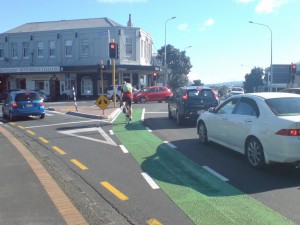 …one larger step for Auckland?
…one larger step for Auckland?
The Changes
Finally, the new southbound cycle lane through the Symonds Street / Mount Eden Road / New North Road intersection has been completed.
Some car parks were removed, and a kerbline, a traffic island and a traffic signal relocated to provide space for the new cycle lane.
Also done or in some cases still coming are several further changes along New North Road, including widening the traffic lane uphill near Porters Road, so cyclists aren’t squeezed out by traffic in the very tight lane anymore, and several changes to parking regulations along NNR, so stopped vehicles create fewer hazardous pinch points for cyclists anymore.
These changes were part of the “Quick Wins” trial project, a cooperation between Auckland Transport and Cycle Action Auckland – to look at existing cycle routes and see what small or medium-sized works could be undertaken to remove cycle hazards on routes where major cycle projects are nowhere in sight at this time.
We would like to thank the people at Auckland Transport for making this trial project possible, and for providing the funding for the works (on top of normal cycling funding) – and we would especially like to thank Amit, the project’s engineer, who displayed a lot of patience with us and with angry locals. Both AT and CAA learned a lot from this project, and it resulted in a few changes that should make cycling on a rather unpleasant street a small bit safer and less hassled.
The Problems
So what problems? Well, they are symbolised by two facts – the southbound-ness of the cycle lane, and the fact that this project was once called “Quick Wins”, yet took way over a year.
In other words, even at this one intersection (Symonds, Mt Eden, New North) the project added cycle lanes only on one third of the three roads. There still is nothing on Mt Eden Road (also a future Auckland Cycle Network route) and nothing uphill on NNR (where we originally intended to add the cycle lane, until the safety audit that was done as part of the project convinced us that with the limited budget, the other direction would be more important). In short, the project didn’t go far enough in funding or scope.
Secondly, it took a lot of time – and a lot of effort-to-result. It started with a comprehensive audit – first CAA then separately Auckland Transport’s safety auditors identified deficiencies on the route. Then we discussed what works would be most important – and which could be realistically funded from the (not irrelevant, but also not exactly endless) budget. Then it had to be designed, and – a major stumbling block – consulted on with the locals.
If the previous steps had offered some hard choices, here it was were Auckland Transport really faced a headwind. Locals, businesses and property developers raised a huge stink at the idea of losing on-street car parking, and we understand, brought out anything from the claim that no cyclists cycled the route anyway, to threatening legal action against Auckland Transport (which would technically be useless – property owners have no right to any on-street car parking – but shows how heated the opposition can get, and how political). And remember that this was opposition in a case were Auckland Transport had in their hands an independent safety audit that discussed how these various changes should be undertaken because the current situation was unsafe! CAA’s friends in cycling circles (thanks especially to Sam!) helped drum up supportive feedback from users of NNR, but the opposition was very real.
Again, we have a lot of respect for Auckland Transport’s project people – they all too often get it in the neck from both sides. Too slow! Not enough! say the cyclists. Too much! Why do you want to damage our livelihoods for some marginal group! shout the locals. As we said, it was an eye-opener for CAA as well. We knew this went on, but being a lot closer to it than usual was still a revelation. No wonder project managers like working on large projects with political support, where they know they have the backing that “the road must get through”. For cycle projects, we are only starting to gain that support.
So what does this mean when even getting small projects through all such stages – from initial assessment, prioritisation, funding, design to finally approval and construction – takes such a long time? To a degree it can probably never be avoided – after all, Auckland Transport needs to make sure the ratepayer money is sensibly spent, and all the relevant and often required design and legal and approval steps are followed.
That wouldn’t be a problem if we had 10-20 such cycle retrofit projects around Auckland at any one time. But on an ad-hoc basis, the results of one single trial project don’t look that impressive, despite the continuing goodwill and effort of both sides that went into the project.
The Solution?
Which brings us to the other positive side of the whole story, beyond the gains the project has created for NNR.
Auckland Transport has come to the conclusion that a lot of cycle routes will need work. Not just extending the cycle network, but also retrofitting existing routes that previous Councils considered “completed”. Groups like CAA and Waitemata Local Board had been highlighting these “incomplete complete” routes for a while, leading AT to undertake a comprehensive stocktake, identifying all the issues on existing routes.
We can now announce that AT has set up an annual (i.e. on-going) upgrade project for these routes, where they will progressively work through the issues (prioritising on the basis of cyclist volume, crash history and a few other factors). The project will use the learnings from the Quick Wins project, and will also work on multiple locations and corridors at once, to get some economies of scale and expertise. CAA will still be involved, but maybe not quite as intensively as during the trial project. The first corridors to be worked on for the 2013/14 financial year are just going through the last decision stage, so maybe in a few weeks we can tell you about them.
This will allow CAA to focus on, for example, drumming up more political backbone for such projects (so project managers don’t have to spend half their time explaining/defending the project to irate opponents), and making sure the funding is increased. Getting a bit more “routine” into upgrading our cycle network will be a very useful thing.



